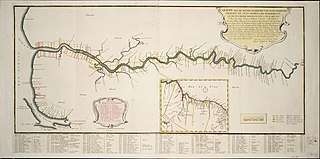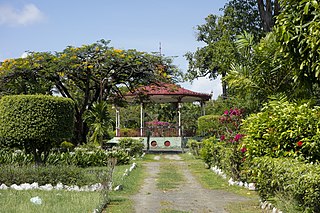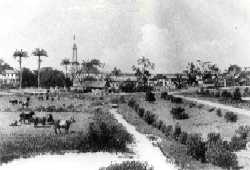
Georgetown is the capital and largest city of Guyana. It is situated in Demerara-Mahaica, region 4, on the Atlantic Ocean coast, at the mouth of the Demerara River. It is nicknamed the "Garden City of the Caribbean." It is the retail, administrative, and financial services centre of the country, and the city accounts for a large portion of Guyana's GDP. The city recorded a population of 118,363 in the 2012 census.

British Guiana was a British colony, part of the mainland British West Indies, which resides on the northern coast of South America. Since 1966 it has been known as the independent nation of Guyana.

Demerara is a historical region in the Guianas, on the north coast of South America, now part of the country of Guyana. It was a colony of the Dutch West India Company between 1745 and 1792 and a colony of the Dutch state from 1792 until 1815. It was merged with Essequibo in 1812 by the British who took control. It formally became a British colony in 1815 till Demerara-Essequibo was merged with Berbice to form the colony of British Guiana in 1831. In 1838, it became a county of British Guiana till 1958. In 1966, British Guiana gained independence as Guyana and in 1970 it became a republic as the Co-operative Republic of Guyana. It was located around the lower course of the Demerara River, and its main settlement was Georgetown.

Linden Forbes Sampson Burnham was a Guyanese politician and the leader of the Co-operative Republic of Guyana from 1964 until his death in 1985. He served as Premier of British Guiana from 1964 to 1966, Prime Minister of Guyana from 1964 to 1980 and then as the first Executive President of Guyana from 1980 to 1985. He is often regarded as a strongman who embraced his own version of socialism.

Guyana Zoo is a zoo located in Georgetown, the capital of Guyana. The zoo officially opened in 1952, but its grounds had been used as botanical gardens since 1895. Some of its most popular attractions are harpy eagles and manatees.

Essequibo was a colony and later county on the Essequibo River in the Guiana region on the north coast of South America. It was a colony of the Dutch West India Company between 1616 and 1792 and a colony of the Dutch state from 1792 until 1815. It was merged with Demerara in 1812 by the British who took control. It formally became a British colony in 1815 till Demerara-Essequibo was merged with Berbice to form the colony of British Guiana in 1831. In 1838, it became a county of British Guiana till 1958. In 1966, British Guiana gained independence as Guyana and in 1970 it became a republic as the Co-operative Republic of Guyana. It was located around the lower course of the Demerara River, and its main settlement was Georgetown.

The Judah P. Benjamin Confederate Memorial at Gamble Plantation Historic State Park, also known as the Gamble Mansion or Gamble Plantation, is a Florida State Park, located in Ellenton, Florida, on 37th Avenue East and US 301. It is home to the Florida Division United Daughters of the Confederacy (UDC).
Buxton is a village in the Demerara-Mahaica Region of Guyana, standing about midway between Georgetown and Enmore.
The Abary River is a small river in northern Guyana that drains into the Atlantic Ocean.
The Railways of Guyana comprised two public railways, the Demerara-Berbice Railway and the Demerara-Essequibo Railway. There are also several industrial railways mainly for the bauxite industry. The Demerara-Berbice Railway is the oldest in South America. None of the railways are in operation in the 21st century.
Company Path Garden is a small garden on the west side of the Avenue of the Republic in Georgetown, Guyana, between Church and North Streets. During colonial times, “company path” was the name given to a road used by the propertied class as an access road from the river to their lands. The company path, in this case, extended from the side of the Demerara River along the path on which the Bank of Guyana was built and eastwards beyond the Avenue of the Republic.
Enmore is a village in the Demerara-Mahaica region along the coastal belt of Guyana. It is about two square miles (5.1 km2) in size and has a multi-ethnic population of 1,002 as of 2012,

Quamina Gladstone, most often referred to simply as Quamina, was a Guyanese slave from Africa and father of Jack Gladstone. He and his son were involved in the Demerara rebellion of 1823, one of the largest slave revolts in the British colonies before slavery was abolished.
Bourda Cemetery is an eighteenth-century cemetery situated on Bourda Street in Georgetown, Guyana. Formerly known as "Bourda's Walk", Bourda cemetery is the oldest cemetery in Georgetown, and the only surviving plantation cemetery in the city. It is considered a national landmark and has been listed as a monument by the National Trust of Guyana.

Elizabeth II was Queen of Guyana from 1966 to 1970, when Guyana was independent sovereign state with a constitutional monarchy. She was also the sovereign of the other Commonwealth realms, including the United Kingdom. Her constitutional roles were delegated to the governor-general of Guyana.

Plantation Peter's Hall was a plantation on the east bank of the River Demerara in Dutch Guiana and British Guiana. It was probably laid out in the mid-eighteenth century and by the early nineteenth century had over 200 slaves before that institution was abolished in the British Empire.
Cummingsburg, or historically Cumingsburg, is a ward in Georgetown, Guyana. It began as 500-acre plantation, La Bourgade about 1759. When Thomas Cumming, a Scotsman, bought the property, he developed a town plan with residential and commercial lots and streets. The town layout was modified after a fire that burnt much of the town in 1864. Today, it is the site of several museums, including a national and anthropological museum.

Guyana Botanical Gardens is a tropical botanical garden in Georgetown, Guyana. It is next to the Guyana Zoo and Castellani House.

Kingston is a former village in Demerara. In 1837, it became a ward of Georgetown. The ward is located along the Atlantic Ocean coast. Kingston is home to many landmarks and historic buildings.
John Meredith Ford was a Guyanese businessman and politician who served as the Lord Mayor of Georgetown, Guyana from 1970 to 1972. During his time in office, Guyana went from being a monarchy under the rule of Elizabeth II to the Co‑operative Republic of Guyana, an independent member of the Commonwealth of Nations. He hosted independence celebrations in the nation's capital and renamed streets to celebrate the country's freedom from British rule. After immigrating to the United States in 1982, Ford worked as a furniture salesman and real estate investor in the Washington, D.C. area.












